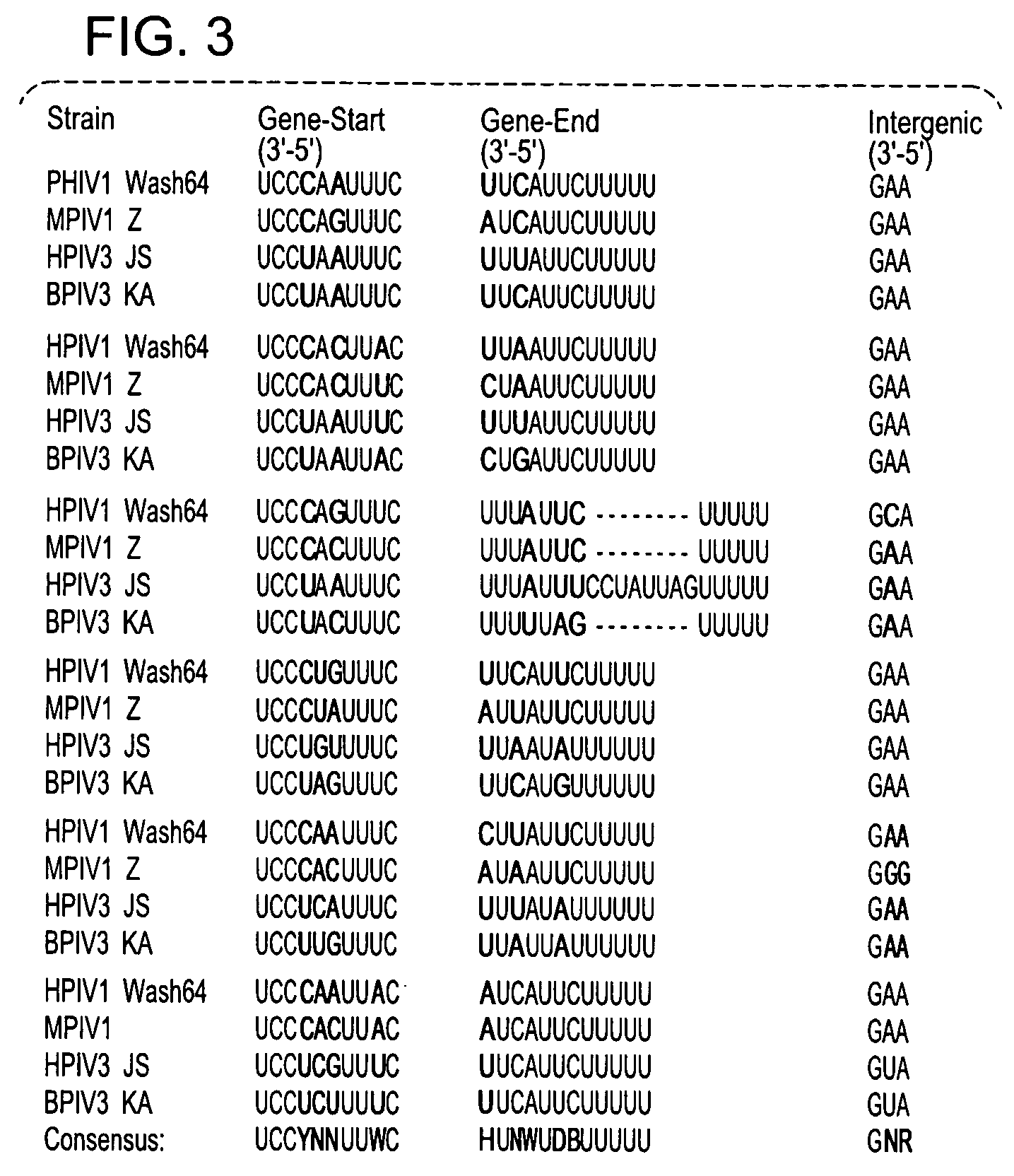Recovery of recombinant human parainfluenza virus type 1 (HPIV1) from cDNA and use of recombinant HPIV1 in immunogenic compositions and as vectors to elicit immune responses against PIV and other human pathogens
a human parainfluenza virus and recombinant technology, applied in the field of recombinant human parainfluenza virus type 1 (hpiv1) from cdna, can solve the problems of dampening the immunogenicity of chimeric hpiv3-1 vaccine candidates against hpiv1 challenge, no vaccines have been approved for any hpiv serotype nor for ameliorating hpiv related illnesses,
- Summary
- Abstract
- Description
- Claims
- Application Information
AI Technical Summary
Benefits of technology
Problems solved by technology
Method used
Image
Examples
example i
Nucleotide Sequence of the Genomic RNA of HPIV1 WASH / 64 and Sequence Comparison with Heterologous Paramyxoviruses
[0216]The complete genomic sequence of HPIV1 WASH / 64 was determined from RT-PCR products amplified from vRNA. The sequence analysis was performed directly on RT-PCR products without a cloning step, and thus yields a consensus sequence. The HPIV1 genome was found to be 15,600 nt in length and conformed to the rule of six (Kolakofsky et al., J. Virol. 72:891-898, 1998, incorporated herein by reference). For comparison, the viral genomic length of other parainfluenza viruses sequenced to date are as follows: (i) among respiroviruses, MPIV1, 15,384 nt; HPIV3, 15,462 nt; and BPIV3, 15,480 nt; (ii) among rubulaviruses, HPIV2, 15,646 nt or 15,665 nt (50), SV5, 15,246 nt, SV41, 15,450 nt (GenBank accession no. X64275), and Newcastle disease virus, 15,186 nt (GenBank accession nos. AF309418 and AF375823).
[0217]The first 96 nt of the 3′ terminus of HPIV1 genomic RNA (FIG. 2A) and t...
example ii
Construction and Rescue of a Full-Length Recombinant HPIV1 Antigenomic cDNA Clone Using Homologous Heterologous, or a Mixed Set of Support Plasmids
[0231]A complete HPIV1 antigenomic cDNA, designated pFLCHPIV1, was constructed which contained two desirable translationally-silent nucleotide changes in the L gene as markers (FIG. 5). The antigenomic cDNA was transfected into HEp-2 cells and virus was recovered using three different sets of N, P, and L support plasmids: N, P, and L of HPIV3 (pTM(N3), pTM(P3), and pTM(L3)), N and P of HPIV1 and L of HPIV3 (pTM(N1), pTM(P1) and pTM(L3)), or N, P, and L of HPIV1 (pTM(N1), pTM(P1) and pTM(L1)). In each case, virus was readily recovered, and the presence of the nucleotide markers was confirmed by RT-PCR and sequence analysis. Amplification was dependent on the addition of RT, indicating that the template was RNA and not contaminating DNA.
[0232]The growth properties in cell culture of rHPIV1 recovered using various sets of support plasmids wa...
example iii
Replication of rHPIV1 and Biologically Derived HPIV1 WASH / 64 in Hamsters
[0234]Wild-type HPIV1 WASH / 64 has been shown to be virulent in human adults, confirming its status as a wild-type virus (Murphy et al., Infect. Immun. 12:62-68, 1975, incorporated herein by reference). The replication of rHPIV1 in the respiratory tract of hamsters was compared to that of the biologically derived HPIV1 WASH / 64 parental strain HPIV1LLC4 to determine whether the recovered rHPIV1 retained the replicative properties of its biological parent in vivo. In this regard, hamsters are accepted in the art as a useful animal model of HPIV infection in humans that provides reasonably correlative findings for such activities as attenuation and immunogenicity between the model and humans, wherein the model is understood to be a less permissive host than humans.
[0235]Two pools of biologically derived HPIV1 WASH / 64 (HPIV1LLC4 a multiply-passaged strain derived from a wild-type parental strain and having five mutat...
PUM
| Property | Measurement | Unit |
|---|---|---|
| concentration | aaaaa | aaaaa |
| temperatures | aaaaa | aaaaa |
| temperatures | aaaaa | aaaaa |
Abstract
Description
Claims
Application Information
 Login to View More
Login to View More - R&D
- Intellectual Property
- Life Sciences
- Materials
- Tech Scout
- Unparalleled Data Quality
- Higher Quality Content
- 60% Fewer Hallucinations
Browse by: Latest US Patents, China's latest patents, Technical Efficacy Thesaurus, Application Domain, Technology Topic, Popular Technical Reports.
© 2025 PatSnap. All rights reserved.Legal|Privacy policy|Modern Slavery Act Transparency Statement|Sitemap|About US| Contact US: help@patsnap.com



